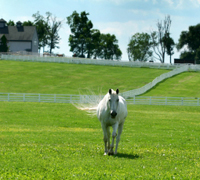 Today, March 20, marks the first day of spring of 2012. For equestrians, this means the start of show season, the re-opening of trails and more hours of sunlight to enjoy in the saddle. It also means flies and biting insects, dangerously lush grass and the realization that you and your horse aren’t quite legged-up for challenging rides after a scaled-back winter riding season.
Today, March 20, marks the first day of spring of 2012. For equestrians, this means the start of show season, the re-opening of trails and more hours of sunlight to enjoy in the saddle. It also means flies and biting insects, dangerously lush grass and the realization that you and your horse aren’t quite legged-up for challenging rides after a scaled-back winter riding season.
- If you haven’t yet scheduled your horse’s spring shots and annual wellness exam, now is the time. Even if your horse doesn’t leave the farm, many preventable equine diseases are transmitted by insects, and it’s important to protect your horse before the bugs are out in full force.
- Monitor your horse’s grass intake. Early spring grass can lead to laminitis. When the first grass of the year sprouts up seemingly overnight, horses tend to overindulge. To prevent your easy-keeper from eating too much grass, you can keep him confined to a stall or dry lot for part of the day, or section off a small part of pasture to limit his access to grass. If those options aren’t practical, you can also outfit him with a grazing muzzle which will slow down his consumption.
- Plan your conditioning schedule. Most parts of the U.S. had an unusually mild winter this year, which means some riders were able to keep a consistent work schedule for their horses throughout the year. However, if you haven’t done much riding over the winter, take your time working back up to long trail rides or strenuous workouts. Click here for more on a safe conditioning regimen.
- Check all of your horse’s winter blankets for tears, then clean them and put them away. There are professional blanket cleaning and repair services that will have your winter wares as good as new, but if you’re handy with a heavy-duty needle and thread, you can patch up your own blankets. You can also clean blankets with soap and water. Use a waterproofing spray after cleaning, then let it dry before packing your blankets away until next winter.
- Clean out your tack trunk and make a list of what you’ll need to purchase for the season. Any liquids that were left in the barn and have frozen and thawed may be ineffective. Make sure you have plenty of fly spray, tack soap, horse shampoo and wound ointment on hand for the busy days ahead.
- It may be tempting to break out the body clippers to expedite the spring shedding process, but once your horse has started to naturally shed his winter coat, it’s best to just let nature take its course. You can, however, help it along with your curry comb, shedding blade and plenty of elbow grease.
Further Reading
Seasonal Horse Care Checklists
Spring Grass Safety
Spring Tune-up
Spring Cleaning around the Barn






Good advice
ditto
Wonderful tips. I think they will be greatly helpful.